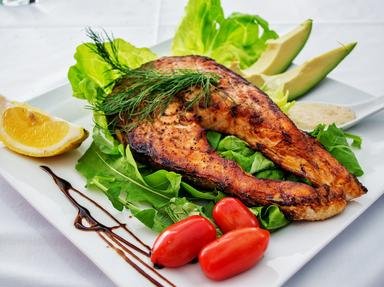Quiz Answer Key and Fun Facts
1. Gelatin is a colorless, odorless substance that is derived from animal collagen. As a gelling agent it has many culinary uses, generally in sweets such as gelatin desserts, marshmallows, and gummy candies. Less well known is the use of gelatin in savory form.
A simple form of savory gelatin is made by boiling animal bones, skin, and/or cartilage. When seasoned, clarified, cooled, and gelled, what is this dish called?
2. When foods are suspended in savory gelatin, the resulting dish is called aspic. The first known recipe for aspic is contained in a 14th century cookbook called "Le Viandier" and described meat in meat jelly. What characteristic of meat in meat jelly might have been especially appreciated in the Middle Ages?
3. Another virtue of aspic is that it uses parts of the animal that might otherwise be wasted. One popular form of aspic that is made from pork uses meat from the head (not including the organs) and sometimes the trotters or other parts. What is this non-dairy cold cut called?
4. The relative stiffness of aspic can be controlled by the use of additional gelatin. Traditionally, there are three textures of aspic: delicate, sliceable, and inedible. What is inedible aspic used for?
5. Sliceable aspic salads provide cooks with an opportunity to show off their compositional skills. What ingredients would NOT typically be found in aspic?
6. Josh Kun's "To Live and Dine in L.A." analyzed over 9,000 restaurant menus from the historic collection in the Los Angeles Public Library. He noticed that aspic dropped off menus in the late 1970s, right around the same time this ingredient began to appear.
7. The French have a word for foods that are cooked as a hot dish but served cold. According to "Larousse Gastronomique," this technique is "one of the most refined in the French culinary repertoire." Aspic is an important ingredient in many of these dishes. What are they called?
8. One of the reasons that Victorians were so enthusiastic about aspics and jellied foods in general was the expanded availability of gelatin molds. Some of the molds were quite fancy and produced dishes that were so elaborate they were used as centerpieces. Other popular molds produced smaller, perfectly spherical jellies. What were the dishes produced using these spherical molds called? (No dance skills were required to use them!)
9. Online resources suggest several different origins for the word "aspic."
One theory is that the word "aspic" derives from the Greek word "aspis," which means "shield." However, most resources suggest that the word derives from a name for a venomous snake. This same snake supposedly had a key role in Cleopatra's suicide. What is this repellent reptile called?
10. In 2001 Laura Shapiro published a book subtitled "Women and Cooking at the Turn of the Century." Its title was also the name of a dish that is said to have won a cooking contest in 1905. This aspic-based dish included various vegetables such as cabbage, red peppers, and celery. What was this dish (and this book) called?
Source: Author
SatchelPooch
This quiz was reviewed by FunTrivia editor
WesleyCrusher before going online.
Any errors found in FunTrivia content are routinely corrected through our feedback system.

